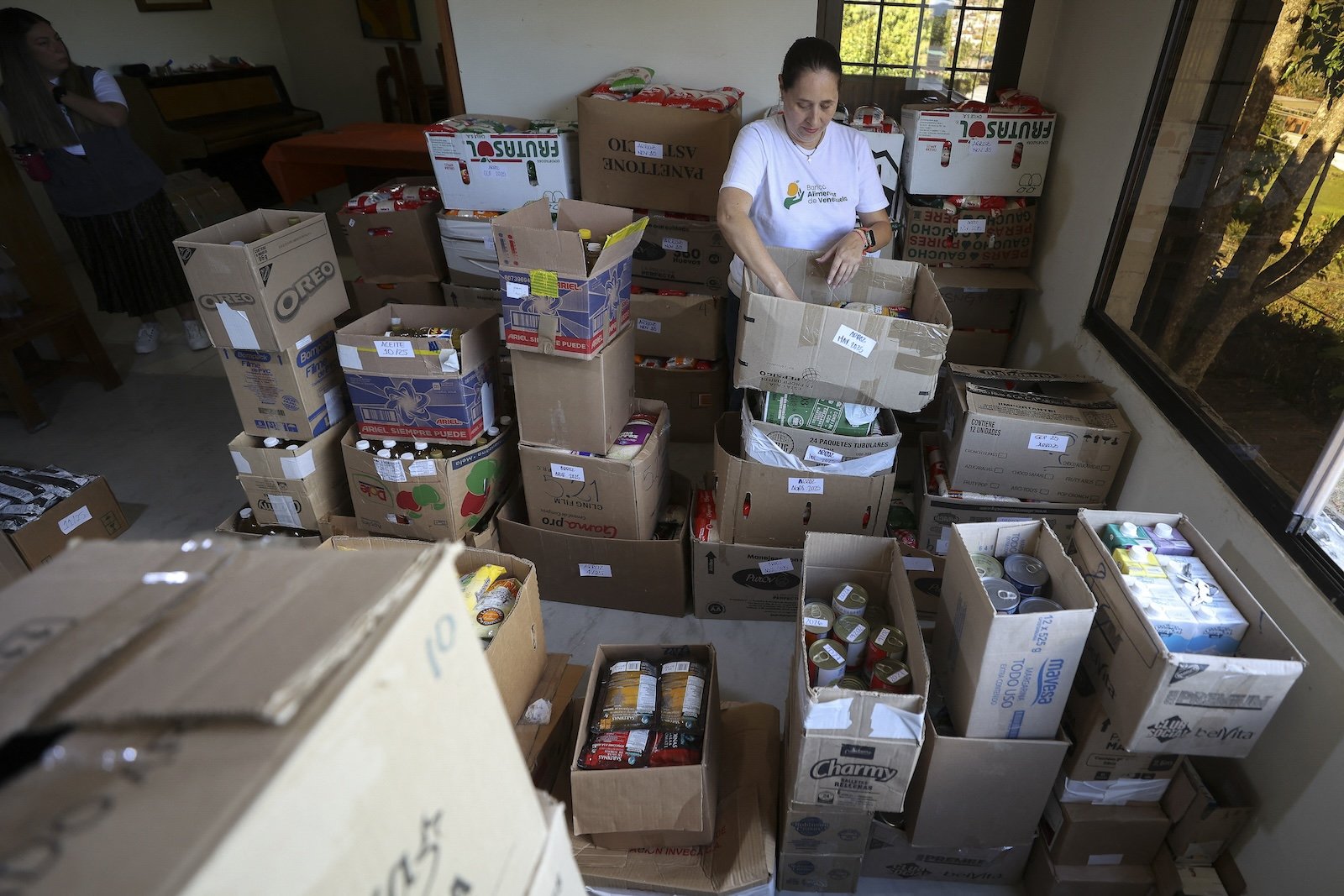Eight to 10 percent of global greenhouse gas emissions come from food wasted somewhere along its journey from farm to table. When that organic waste ends up in a landfill, it emits methane, a powerful greenhouse gas, as it slowly decomposes.
Food banks can help prevent food waste from occurring, by rescuing unsold food from grocers and retailers and redistributing it to families and individuals in need. Now, a small number of food banks around the world have recently started tracking their operations and quantifying how many emissions they’re avoiding — with the goal of using that data to better aid decarbonization efforts, as well as to sell carbon credits.
These carbon credits could help open up new avenues to raise money for food banks at a time when other sources of funding, like foreign aid from wealthy to developing countries, are threatened, according to the Global FoodBanking Network, or GFN. The nonprofit organization has piloted this carbon credit program in Mexico and Ecuador and is working to bring food banks in 12 other countries onboard.
But the carbon markets where such credits are traded have been heavily criticized for rampant fraud; the harshest critics say that purchasing credits representing avoided would-be emissions amounts to greenwashing. The rollout of GFN’s program for calculating food banks’ carbon footprint raises the question of whether nonprofits with social and environmental missions should make use of these controversial accounting instruments to stay afloat and further their impact.
Carbon markets are marketed as a way for big polluters (think: airlines, large corporations, even national governments) to minimize their impact on the environment without fundamentally changing the way they operate. In theory, buyers can emit carbon into the atmosphere and then purchase credits — which represent emission reductions — to make up for it, allowing them to claim their operations are carbon-neutral.
The problem is that, without rigorous standards and verification to show that credits represent additional, permanent cuts in emissions, analysis has shown that most of these credits are essentially meaningless. Among other issues, sellers and certification organizations have struggled to meet the additionality standard by proving that, if a buyer had not purchased the credits, the reduction of emissions would not have happened.
Socially driven and environmentally conscious nonprofits have experimented with selling carbon credits. For example, conservation programs have long offered offsets on carbon markets based on the idea that protected ecosystems sequester emissions, said Khaled Diab, communications director at Carbon Market Watch, a nonprofit watchdog organization that studies various carbon pricing programs. These groups can fall victim to overestimating just how much their work reduces emissions: For instance, a Bloomberg investigation in 2020 into The Nature Conservancy’s forest-based carbon credits program found that many of its emissions reductions were likely bogus. The Nature Conservancy has not stopped selling credits, but launched a review of its own practices and canceled one project the organization said did not meet its newly developed internal criteria.

Andrew Lichtenstein / Corbis via Getty Images
In April, Carbon Market Watch released a report on programs that give gas or electric stoves to families in poor countries who would otherwise chop down and burn wood to cook food. These programs sold carbon credits based on the reduction in emissions that came from families going from burning wood to using a cleaner source of fuel. “We found that the climate impact is overstated significantly,” said Diab, in part because of assumptions the programs made when measuring emissions.
In the process of developing the Food Recovery to Avoid Methane Emissions, or FRAME, methodology, GFN was aware of these issues, said Ana Catalina Suarez Peña, head of strategy and innovation for the organization.
“All the scandals around voluntary carbon markets are associated with the rigor of the monitoring, reporting, and verification schemes” that underpin them, she said. If carbon credit sales are growing, and global temperatures are also continuing to rise, then “something is not correct,” said Suarez Peña.
So when GFN was researching how to quantify how many emissions it saves by diverting food to landfills, the organization was focused on ensuring “what we are reporting is real,” said Suarez Peña. The methodology is in the process of being certified by the Gold Standard, a standard-setting organization that verifies credits sold through voluntary carbon markets, according to GFN.
This involved getting specific about what counts as an avoided emission. In this case, participating food banks are comparing the emissions they run up by transporting rescued food, refrigerating it, and potentially losing some edible food to spoilage to a scenario where grocers and retailers dispose of their food in a way that doesn’t end up feeding people — i.e., sending it to a landfill or to be made into compost or animal feed.
The FRAME methodology only looks at food intended for human consumption that would otherwise arrive at one of these destinations but is then diverted by food banks and given to people who will eat it. It also only looks at food that is donated to food banks, rather than purchased by them.
But some experts say this framework is flawed. For one, it assumes that if shops don’t donate the leftover food, then the food will inevitably end up going to waste, said Marc Roston, a senior research scholar at the Stanford Doerr School of Sustainability. That ignores a scenario where shops could get rid of leftover food by selling it at a discount — perhaps even directly to the food bank. “The food bank buys food very inexpensively: no credits. The grocery store gives food to the food bank: credits issued. That’s not good carbon accounting,” said Roston.

Pedro Mattey / AFP via Getty Images
In order for carbon credits to represent a legitimate offset in emissions, they also need to reflect new or additional work being done to reduce climate pollution. The idea is that, by selling credits, organizations can prevent even more carbon emissions than they were preventing before. The food banks in GFN have long diverted food at risk of being wasted — but according to GFN, its carbon credits program represents additional work in the sense that the funds generated by selling credits allow food banks to expand their capacity to rescue food. Suarez Peña said that member food banks ensure they’re capturing accurate data by tracking operations-related emissions in real-time and submitting quarterly reports to GFN.
Most food banks within GFN operate with a budget of $1 million or less, according to the organization — meaning that even relatively small losses in funding can have a big impact on its ability to stay open. As the Trump administration retracts billions of dollars in U.S. foreign aid, European countries are also reconsidering how much money they spend abroad. That means that food banks in the Global South, whose budgets are typically dependent on receiving funding from wealthier nations, are newly interested in exploring alternative sources of funding.
The Mexican Food Banking Network, or BAMX, which previously sold carbon credits under a separate methodology, participated in the pilot to test out the FRAME system. Asked what BAMX learned from the experience, BAMX head Mariana Jiménez said in an interview in Spanish that the organization has a greater awareness of its environmental impact. According to Suarez Peña, the food bank in Quito, Ecuador, that participated in the FRAME pilot has used the data it has collected to have conversations with representatives from the national government about Ecuador’s decarbonization platform.
But critics like Roston argue that unless credits represent actual carbon removed from the atmosphere — for example, by turning food scraps into biochar and then using the biochar to store carbon — they are unlikely to represent real, permanent emissions reductions. “I think there are probably better finance tools to fund food banks than voluntary carbon markets,” said Diab, of Carbon Market Watch.
Suarez Peña, however, sees value in food banks auditing their own operations and sharing that data extending far beyond carbon markets. “I think in the coming years, having better, accurate, and robust data will be the way to demonstrate how everyone is contributing” to climate targets, she said. As countries prepare to report on their climate progress at the annual United Nations climate summit later this year, data on food waste will be extremely valuable, she argued — even though most countries’ accounting methods do not yet make the connection between food waste and emissions. Suarez Peña hopes food banks can help “connect both in just one conversation.”
toolTips(‘.classtoolTips4′,’The process of reducing the emission of carbon dioxide and other greenhouse gases that drive climate change, most often by deprioritizing the use of fossil fuels like oil and gas in favor of renewable sources of energy.’); toolTips(‘.classtoolTips6′,’A powerful greenhouse gas that accounts for about 11% of global emissions, methane is the primary component of natural gas and is emitted into the atmosphere by landfills, oil and natural gas systems, agricultural activities, coal mining, and wastewater treatment, among other pathways. Over a 20-year period, it is roughly 84 times more potent than carbon dioxide at trapping heat in the atmosphere.‘);
This story was originally published by Grist with the headline Food banks have long prevented emissions. Now they’re getting into the carbon credit business. on Aug 7, 2025.














